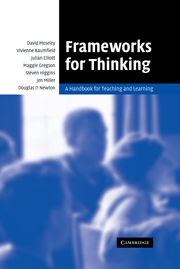Book contents
- Frontmatter
- Contents
- List of figures
- List of tables
- Notes on authors
- Foreword
- Acknowledgments
- Introduction
- 1 The nature of thinking and thinking skills
- 2 Lists, inventories, groups, taxonomies and frameworks
- 3 Frameworks dealing with instructional design
- 4 Frameworks dealing with productive thinking
- 5 Frameworks dealing with cognitive structure and/or development
- 6 Seven ‘all-embracing’ frameworks
- 7 Moving from understanding to productive thinking: implications for practice
- References
- Index
3 - Frameworks dealing with instructional design
Published online by Cambridge University Press: 22 September 2009
- Frontmatter
- Contents
- List of figures
- List of tables
- Notes on authors
- Foreword
- Acknowledgments
- Introduction
- 1 The nature of thinking and thinking skills
- 2 Lists, inventories, groups, taxonomies and frameworks
- 3 Frameworks dealing with instructional design
- 4 Frameworks dealing with productive thinking
- 5 Frameworks dealing with cognitive structure and/or development
- 6 Seven ‘all-embracing’ frameworks
- 7 Moving from understanding to productive thinking: implications for practice
- References
- Index
Summary
Introduction
Every instructional design system is underpinned in some way or other by a theory of learning and a way of ‘knowing’ or ‘seeing’ the world. While learning theory describes and attempts to explain how people learn, the main aim of instructional design is to provide guidance on the practical task of designing learning experiences. Placing instructional design theorists on an epistemological continuum, behaviourist systems lie towards the positivist end of the scale and the post-modernist concern with critical theory at the opposite pole. Nearer the centre, but still on the positivist side, are the cognitivists, with their combination of positivism and interpretation. Close by, but nearer to the post-modern end of the scale, are the constructivists, with their orientation towards interpretation and criticism. While ‘behavioural objectivists’ see learning largely in terms of response strengthening, ‘cognitivists’ tend to explain it in terms of knowledge acquisition, and ‘constructivists’ construe learning in terms of the dialogic generation of ‘constructions’.
It is interesting to note that it was the more behaviouristic branches of instructional design which held most immediate appeal for the early–mid twentieth-century industrialists and educational policy-makers. One of the most popular branches of this approach to instructional design became known as ‘programmed instruction’.
- Type
- Chapter
- Information
- Frameworks for ThinkingA Handbook for Teaching and Learning, pp. 44 - 118Publisher: Cambridge University PressPrint publication year: 2005



